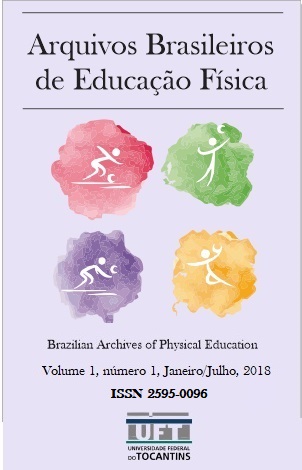Qualidade de vida e equilíbrio de idosas praticantes de hidroginástica de um Programa de Atividades Físicas e Esportivas
DOI:
https://doi.org/10.20873/abef.v1i1.6239Palabras clave:
Adultas mayores; Calidad de vida; SF-36; Equilibrio; HidrogimnasiaResumen
Resumen
Introducción: La hidrogimnasia propicia una mejor calidad de vida en relación a los beneficios que ofrece al adulto mayor, proporcionando una vida más saludable y activa a esa población. Además, la práctica regular de actividad física está directamente ligada al equilibrio. Objetivo: analizar la calidad de vida y el equilibrio de las adultas mayores participantes de hidrogimnasia del Programa de Actividades Físicas y Deportivas, de la ciudad de Gurupi-TO. Metodología: se aplicó el Short-Form Health Survey (SF-36) y la Escala de Equilibrio de Berg (EEB) en 19 adultas mayores (67,47 ± 5,66) practicantes regulares de hidrogimnasia en el Programa de Actividades Físicas y Deportivas de la ciudad de Gurupi en Tocantins. Resultados: con excepción de los aspectos emocionales, los puntajes encontrados en el SF-36 se consideraron satisfactorios en los otros ámbitos: aspectos físicos (60,5), dolor (64), estado general de salud (79,8), vitalidad (62,6), aspectos sociales (77,1), salud mental (75,7). En cuanto a la EEB se obtuvo un excelente resultado (53,7 ± 2,05). Conclusión: a pesar de no tener un buen aspecto emocional, las adultas mayores practicantes de hidrogimnasia en el Programa de Actividad Físicas y Deportivas, de la ciudad de Gurupi/Tocantins/Brasil, poseen una buena calidad de vida, y un excelente equilibrio.
Palabras clave: Adultas mayores; Calidad de vida; SF-36; Equilibrio; Hidrogimnasia
Citas
Referências
INSTITUTO BRASILEIRO DE GEOGRAFIA E ESTATÍSTICA. Proporção de idosos de 60 anos ou mais e de 65 anos ou mais de idade, Brasil, 1999/2009. Disponível em: http://teen.ibge.gov.br/mao-na-roda/idosos
WORLD HEALTH ORGANIZATION. Active Ageing. A Contribution of the World Health Organization to the second United Nations World Assembly on Aging. A Police Framework, Madrid, Spain. April, 2017.
PIMENTA, Fausto Aloísio Pedrosa et al. Avaliação da qualidade de vida de aposentados com a utilização do questionário SF-36. 2008.
Silva A, Almeida GJM, Cassilhas RC, Cohen M, Peccin MS, Tufik S et al. Equilíbrio, coordenação e agilidade de idosos submetidos à pratica de exercícios físicos resistidos. Revista Brasileira Medicina Esporte, São Paulo, Mar/Abr, 2008; v.14, n.2.
Sova R. Hidroginástica na terceira idade. Manole, São Paulo, 1998.
Ciconelli RM, Ferra, MB, Santos W, Meinão I, Quaresma MR. Tradução para a língua portuguesa e validação do questionário genérico de avaliação de qualidade de vida SF-36 (Brasil SF-36). Rev Bras Reumatol.1999;39(3):143-50
Miyamoto ST, Lombardi Junior I, Berg KO Ramos LR, Natour. J. Brazilian version of the Berg balance scale. Braz J Med Biol Res 2004; 37(9):1411-21
Berg K, Wood-Dauphinée S, Williams JI. Measuring balance in the elderly: preliminary development of an instrument. Physiotherapy Canada 1989; 41: 304-11
Berg K, Maki B, Williams J. Clinical and laboratory measures of postural balance in an elderly population. Arch Phys Med Rehabil 1992; 73: 1073–80.
PIMENTA, Fausto Aloísio Pedrosa et al. Avaliação da qualidade de vida de aposentados com a utilização do questionário SF-36. 2008.
MOTA, Jorge et al. Atividade física e qualidade de vida associada à saúde em idosos participantes e não participantes em programas regulares de atividade física. Revista brasileira de educação fìsica e esporte, v. 20, n. 3, p. 219-225, 2006
Acree LS, Longfors J, Fjeldstad AS, et al.: Physical activity is related to quality of life in older adults. Health and Quality of Life Outcomes 4 (37): 1-6, 2006.
Binder EF, Schechtman KB, Ehsani AA, et al.: Effects of exercise training on frailty in community-dwelling older adults: results of a randomized, controlled trial. JAGS 50 (12): 1921-8, 2002.
Caporicci S, Neto MFO. Estudo comparativo de idosos ativos e inativos através da avaliação das atividades da vida diária e medição da qualidade de vida; Motricidade. 2011;7(2);15-24.
Pimentel RM, Scheicher ME. Comparação do risco de queda em idosos sedentários e ativos por meio da escala de equilíbrio de Berg. Fisioterapia e Pesquisa, São Paulo, janeiro/fevereiro, 2009; v.16, n.1, p.6-10.
Descargas
Publicado
Cómo citar
Número
Sección
Licencia
Proposta de Aviso de Direito Autoral Creative Commons
1. Proposta de Política para Periódicos de Acesso Livre
Autores que publicam nesta revista concordam com os seguintes termos:
a. Autores mantém os direitos autorais e concedem à revista o direito de primeira publicação, com o trabalho simultaneamente licenciado sob a Licença Creative Commons Attribution que permite o compartilhamento do trabalho com reconhecimento da autoria e publicação inicial nesta revista.
b. Autores têm autorização para assumir contratos adicionais separadamente, para distribuição não-exclusiva da versão do trabalho publicada nesta revista (ex.: publicar em repositório institucional ou como capítulo de livro), com reconhecimento de autoria e publicação inicial nesta revista.
c. Autores têm permissão e são estimulados a publicar e distribuir seu trabalho online (ex.: em repositórios institucionais ou na sua página pessoal) a qualquer ponto antes ou durante o processo editorial, já que isso pode gerar alterações produtivas, bem como aumentar o impacto e a citação do trabalho publicado (Veja O Efeito do Acesso Livre).




